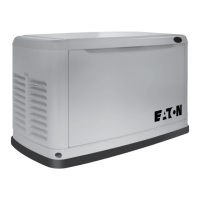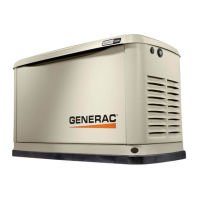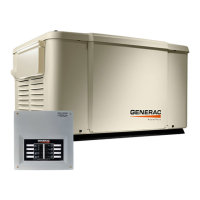OPERATIONAL TESTS
PART 5
Page 145
The transfer switch is now electrically “hot”, contact
with “hot” parts will result in extremely hazardous and
possibly fatal electrical shock. Proceed with caution.
5. Use an accurate AC voltmeter to check utility power
source voltage across transfer switch Terminals N1 and
N2. Nominal line-to-line voltage should be 240 volts AC.
6. Check utility power source voltage across Terminals N1
and the transfer switch neutral lug; then across Terminal
N2 and neutral. Nominal line-to-neutral voltage should be
120 volts AC.
7. When certain that utility supply voltage is compatible with
transfer switch and load circuit ratings, turn off the utility
power supply to the transfer switch.
8. On the generator panel, set the AUTO-OFF-MANUAL
switch to MANUAL. The engine should crank and start.
9. Let the engine warm up for about five minutes to allow
internal temperatures to stabilize. Then, set the generator
main circuit breaker to its “ON” (or closed) position.
Proceed with caution! Generator power voltage is
now supplied to the transfer switch. Contact with live
transfer switch parts will result in dangerous and
possibly fatal electrical shock.
10. Connect an accurate AC voltmeter and a frequency meter
across transfer switch Terminal Lugs E1 and E2. Voltage
should be 240-254 volts; frequency should read about 60
Hertz.
11. Connect the AC voltmeter test leads across Terminal Lug
E1 and neutral; then across E2 and neutral. In both cases,
voltage reading should be 121-126 volts AC.
12. Set the generator main circuit breaker to its OFF (or open)
position. Let the engine run at no-load for a few minutes to
stabilize internal engine generator temperatures.
13. Set the generator AUTO-OFF-MANUAL switch to OFF. The
engine should shut down.
Note: It is important that you do not proceed until you are
certain that generator AC voltage and frequency are correct
and within the stated limits. Generally, if both AC frequency
and voltage are high or low, the engine governor requires
adjustment. If frequency is correct, but voltage is high or
low, the generator voltage regulator requires adjustment.
GENERATOR TESTS UNDER LOAD
To test the generator set with electrical loads applied, proceed
as follows:
1. Set generator main circuit breaker to its OFF (or open)
position.
2. Turn OFF all loads connected to the Transfer Switch
Terminals T1 and T2.
3. Set the generator AUTO-OFF-MANUAL switch to OFF.
4. Turn off the utility power supply to the transfer switch,
using the means provided (such as a utility main line
circuit breaker).
Do not attempt manual transfer switch operation until
all power voltage supplies to the transfer switch have
been positively turned off. Failure to turn off all power
voltage supplies will result in extremely hazardous and
possibly fatal electrical shock.
5. Manually set the transfer switch to the STANDBY
position, i.e., load terminals connected to the generator
E1/E2 terminals. The transfer switch operating lever
should be down.
6. Set the generator AUTO-OFF-MANUAL switch to MANUAL.
The engine should crank and start immediately.
7. Let the engine stabilize and warm up for a few minutes.
8. Set the generator main circuit breaker to its ON (or
closed) position. Loads are now powered by the standby
generator.
9. Turn ON electrical loads connected to transfer switch T1
and T2. Apply an electrical load equal to the full rated
wattage/amperage capacity of the installed generator.
10. Connect an accurate AC voltmeter and a frequency meter
across Terminal Lugs E1 and E2. Voltage should be
greater than 240 volts and frequency should be 60 Hz.
11. Let the generator run at full rated load for 20-30 minutes.
Listen for unusual noises, vibration or other indications
of abnormal operation. Check for oil leaks, evidence of
overheating, etc.
12. When testing under load is complete, turn off electrical
loads.
13. Set the generator main circuit breaker to its OFF (or open)
position.
14. Let the engine run at no-load for a few minutes.
15. Set the AUTO-OFF-MANUAL switch to OFF. The engine
should shut down.
Section 5.1
System Functional Tests

